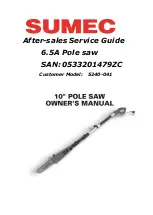
12
Figure 7-5
7.7
Feed pressure adjustment
Feed pressure is the amount of weight the bow is
allowed to exert upon the workpiece. Turn handle
(O, Figure 7-6) clockwise to decrease feed
pressure; counterclockwise to increase feed
pressure.
A good indication of proper feed pressure is the
color and shape of the cutting chips. If the chips are
thin or powdered, increase feed pressure. If chips
are burned and heavy, decrease feed pressure. If
they are still burned and heavy, reduce blade speed.
Optimum feed pressure has been set when chips
are curled, silvery, and warm.
Figure 7-6
7.8
Blade-to-table squareness
The blade must be perpendicular to table to ensure
a straight cut. This setting should be checked.
Special blade setting gauges can be purchased for
this type of inspection; however, it can also be done
using more common shop items, as follows.
1. “Extend” the surface of blade by clamping a
straight, flat object to blade. (Figure 7-7 uses a
small, lightweight aluminum ruler.) Use a
lightweight clamp.
Figure 7-7
2. Place a square on table and against ruler. The
square should lie flat against ruler without a
gap.
3. If there is a gap, loosen bolt (H, Figure 7-4) on
each blade guide assembly and rotate blade
guide assembly until gap is eliminated between
square and ruler.
4. Retighten bolts (H, Figure 7-4).
5. After making this adjustment, be sure to re-
check other blade adjustments as noted in this
manual.
7.8.1
Test cut to verify adjustment
Test cuts can be used to determine whether or not
the blade is accurately adjusted. Use 2-inch round
bar stock to perform these test cuts, as follows:
1. With bar stock securely clamped in vise, make
a cut through the bar stock. (See Figure 7-8.)
2. Mark the top of bar stock.
3. Move the bar stock about 1/4-inch past the
blade so that you can begin a second cut.
4. Rotate the bar stock 180 degrees so the mark
you made is now at bottom of cut.
5. Make a cut through the bar stock.
6. Use a micrometer to measure the thickness
variation of the disk you have cut from the bar
stock. Measure at top and bottom of disk.
The saw blade can be considered correctly adjusted
when the variation measure is no more than 0.012
inch across the face of the disk.
If you do not have a piece of 2-inch bar stock
available for a test cut, use a larger diameter test
piece rather than a smaller one. [Note: Do not
exceed material capacity of the machine – refer to
specifications.] The maximum thickness variation
on any test piece should be no more than 0.003
inch, per side, per inch of stock diameter.
Summary of Contents for HVBS-56V
Page 18: ...18 11 1 1 HVBS 56V Bed Assembly Exploded View...
Page 19: ...19 11 1 2 HVBS 56V Bow Assembly Exploded View...
Page 26: ...26 This page intentionally left blank...
Page 27: ...27 This page intentionally left blank...
Page 28: ...28 427 New Sanford Road LaVergne Tennessee 37086 Phone 800 274 6848 www jettools com...













































